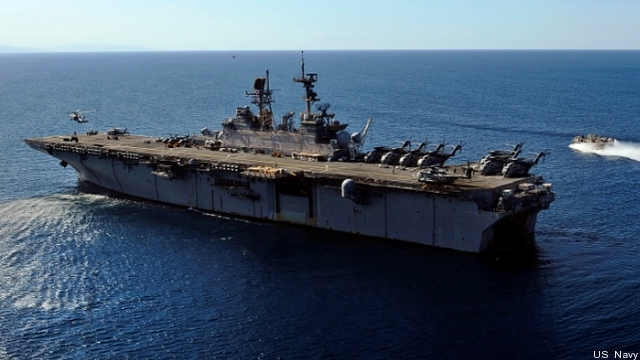JUSTIN KATZ

WASHINGTON — The US Navy for the first time has permanently installed a 3D printer capable of producing metal components onboard the amphibious ship Bataan (LHD-5), paving the way for the fleet to much more rapidly and effectively maintain vessels at sea.
The service announced on Friday morning the installation was completed. The printer itself is similar in size an SUV, weighing 4,700 pounds and standing six-and-a-half feet tall, 68 inches back to front and 8 feet wide.
The printer has “already proven itself shipboard on a handful of aircraft carriers and at least one submarine tender,” Jim Pluta, additive manufacturing program manager for Naval Sea Systems Command, told Breaking Defense in an interview prior to the installation.
But the Bataan is the first to permanently receive a metal-based printer. In addition to the metal printer, the ship also received a polymer-based printer that weighs roughly 100 pounds.
Capt. Paul Burkhart, the Bataan’s executive officer, told Breaking Defense during the same interview that his ship was selected based on the timing of its maintenance period as well as the fact the vessel had space for the machines in a room previously being used by the meteorological team that was no longer aboard.
Burkhart said he expects the new printers will be most useful in supplementing auxiliary parts for larger systems. For example, the various valves onboard a ship all have exterior hand wheels, which sometimes get damaged from repeat use or other objects knocking into them.
Ordering a new valve can take days to have the request fulfilled and the items delivered to the ship. By contrast, printing a new hand wheel only takes a few hours and doesn’t cost as much money, Burkhart said.
Before using 3D-printed components onboard a ship, the fleet requires approval from Naval Sea Systems Command. Pluta said the procurement agency has approved 320 polymer parts for use shipboard and are in the process of identifying “ideal candidate” components to be printed using the new metal printer.
Pluta said one of the challenges of bringing metal printers onboard ships has been the methods they each use to manufacture components. Some printers use metal powders, which can be volatile, making them unsafe for a ship underway. The printer selected for the Bataan uses “wire welding,” similar to the welding techniques already used onboard Navy ships.
Burkhart said his ship has designated five sailors from three different military occupational specialties to be responsible for learning how to operate the new printers: machinist repairman, hull technician and damage controlman. But he also predicted it would not be difficult for the next generation of sailors — some of whom already have experience using 3D printers while in high school — to be trained up on the technology.
“I think this is going to be something where, with the proper training and through the JQR, our job qualification records, we could probably train up almost any sailor to be able to use this equipment,” he said.
No comments:
Post a Comment